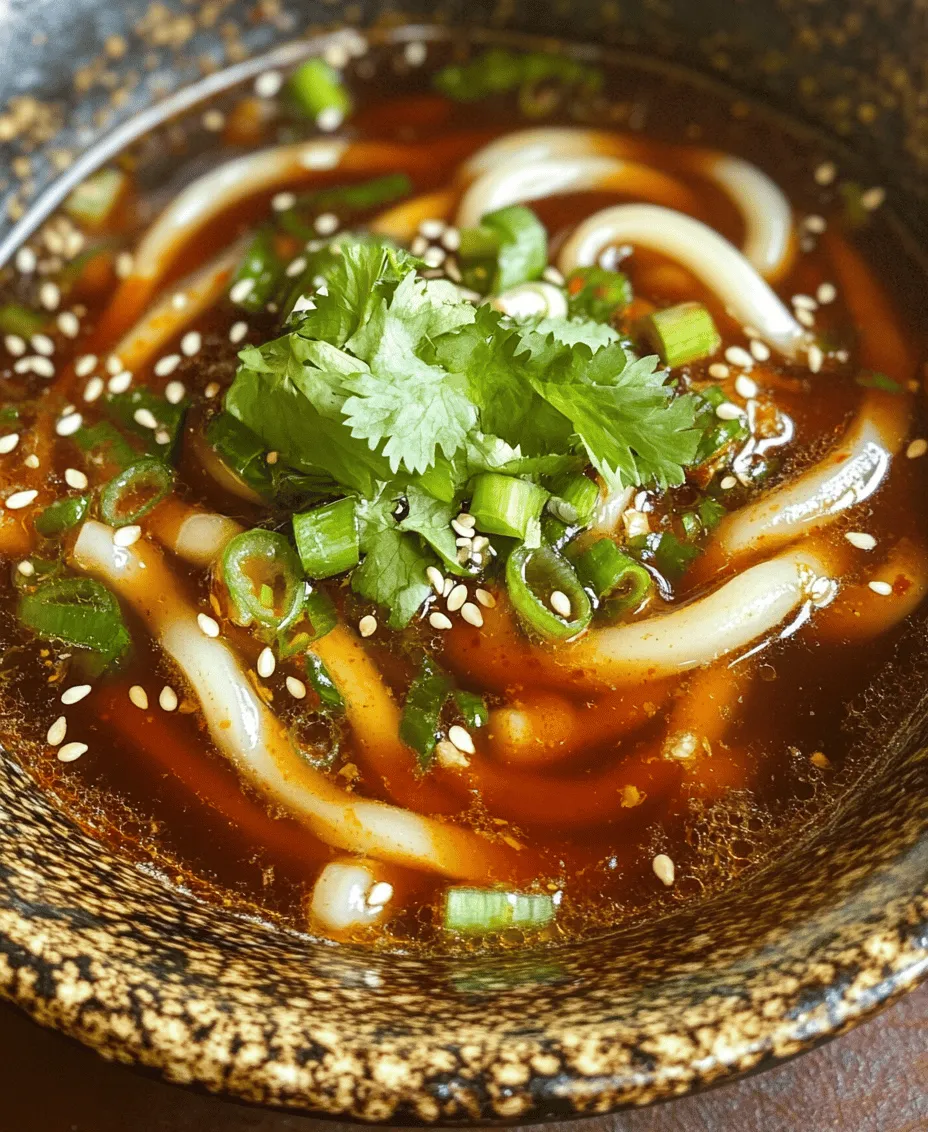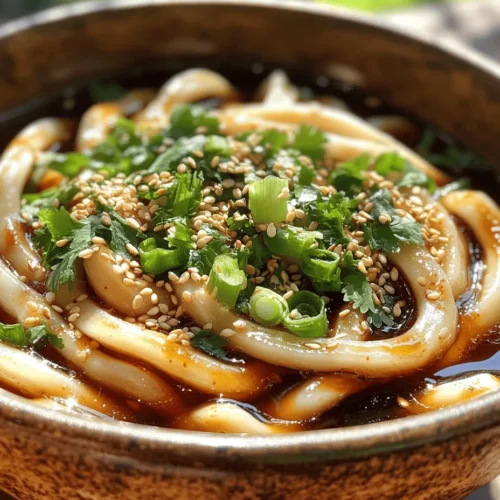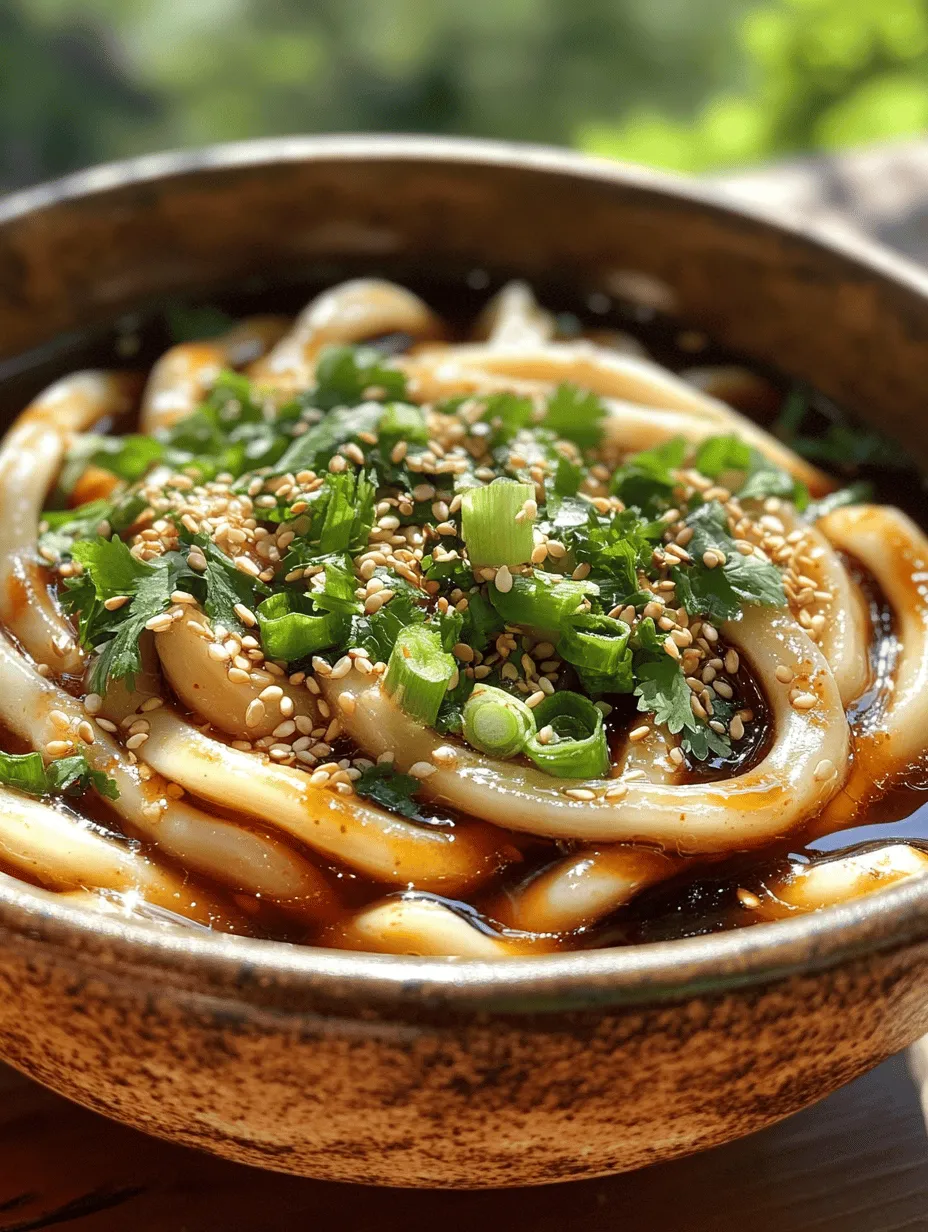Introduction
In today’s fast-paced world, finding time to prepare a satisfying meal can feel like a daunting task. However, the 10 Minute Chili Oil Udon Noodles offer a delightful solution that merges speed with flavor, making it an ideal choice for busy individuals and families. This dish is not just about convenience; it also presents an exciting blend of textures and tastes that can transform a simple weeknight dinner into a culinary experience.
What sets these udon noodles apart is their ability to absorb flavors, making them the perfect base for the spicy, aromatic chili oil that elevates this dish to new heights. Moreover, the versatility of chili oil allows for a myriad of customization options, catering to various taste preferences and dietary restrictions. Whether you’re a novice in the kitchen or an experienced chef looking for a quick meal, this recipe is designed to be approachable and adaptable.
Throughout this article, we will dive deep into the recipe for 10 Minute Chili Oil Udon Noodles, exploring its origins, nutritional benefits, and step-by-step instructions to ensure that you can recreate this dish with ease and confidence.
The Appeal of Udon Noodles
Exploring the Softness and Versatility of Udon
Udon noodles, a staple in Japanese cuisine, are renowned for their thick, chewy texture and rich flavor. Made primarily from wheat flour, water, and salt, these noodles are typically served in broth or stir-fried, making them incredibly versatile. Their soft and slightly dense nature allows them to absorb flavors beautifully, making every bite a delightful experience.
Udon noodles can be enjoyed in a variety of dishes. They are traditionally served in hot broth, known as “kake udon,” where they soak up the savory liquid, creating a comforting meal. Alternatively, they can be stir-fried with a mix of vegetables and proteins, as seen in dishes like “yaki udon.” The adaptability of udon makes it an excellent choice for experimenting with different sauces and toppings, such as our spicy chili oil, which adds a robust kick to the dish.
The appeal of udon noodles lies not only in their taste but also in their texture. The thick, chewy strands provide a satisfying mouthfeel, making them perfect for those who enjoy a hearty pasta experience. This unique quality has made udon a beloved choice not just in Japan but across the globe, where it has been embraced by various culinary traditions.
Chili Oil: A Flavorful Staple
Understanding Chili Oil and Its Importance
Chili oil is a beloved condiment in many culinary traditions, particularly in Asian cuisines. It is made by infusing oil with dried chili peppers, garlic, and other spices, creating a vibrant, aromatic oil that adds depth and heat to various dishes. The rich, spicy flavor profile of chili oil enhances the overall taste of meals, making it a staple in many households.
The significance of chili oil extends beyond its flavor; it also serves as a versatile ingredient that can be used in marinades, dressings, and as a dipping sauce. It is popular in dishes like dumplings, noodle soups, and stir-fries, where it adds a pronounced kick and a burst of flavor.
When it comes to chili oil, you have the option of purchasing it pre-made from the store or making your own at home. While store-bought chili oil offers convenience, homemade versions allow for greater control over the ingredients and spice levels. Making chili oil at home can be a rewarding experience, as you can customize the flavors to suit your preferences.
In this recipe, we will focus on creating a simple yet flavorful chili oil that complements the udon noodles perfectly. The homemade chili oil will not only enhance the dish but also provide a satisfying experience for those who enjoy a bit of heat in their meals.
Recipe Breakdown
Ingredients Overview
To prepare the 10 Minute Chili Oil Udon Noodles, you will need the following ingredients:
– Udon Noodles: The star of the dish, these chewy noodles provide the perfect base. You can find them fresh or frozen in most grocery stores. If udon noodles are unavailable, you may substitute with other noodles like soba or rice noodles, but keep in mind that the texture will vary.
– Chili Oil: A must-have for this recipe. You can either use store-bought chili oil or prepare your own using ingredients like dried red chili flakes, garlic, and sesame oil.
– Soy Sauce: This ingredient adds an umami flavor that complements the spiciness of the chili oil. For a gluten-free option, you can use tamari sauce instead.
– Garlic: Fresh minced garlic will elevate the flavor of the dish, providing aromatic depth.
– Vegetables: Feel free to add any vegetables you have on hand, such as bell peppers, broccoli, or carrots. These will add color and nutrition to the dish.
– Protein (optional): You can add your choice of protein like tofu, chicken, or shrimp to make it more filling.
– Sesame Seeds: Toasted sesame seeds can be sprinkled on top for added flavor and crunch.
Each ingredient plays a vital role in creating the overall flavor profile of the dish. The udon noodles serve as a base, while the chili oil infuses heat and aroma. Soy sauce contributes a savory element, and the fresh garlic adds a punch of flavor. Adding vegetables not only enhances the nutritional value but also adds vibrant colors to the dish, making it visually appealing.
Step-by-Step Cooking Instructions
Now that we have gathered all the ingredients, let’s move on to the cooking process. Here’s a detailed guide to preparing your 10 Minute Chili Oil Udon Noodles:
1. Cook the Udon Noodles:
– Bring a large pot of salted water to a boil. Add the udon noodles and cook according to package instructions, usually around 4-5 minutes for fresh noodles and about 7-8 minutes for frozen. Stir occasionally to prevent sticking.
– Once cooked, drain the noodles in a colander and rinse under cold water to stop the cooking process. This step also helps to remove excess starch, keeping the noodles from becoming gummy.
2. Prepare the Chili Oil:
– If you’re making homemade chili oil, heat a small saucepan over medium heat. Add a neutral oil, such as vegetable or canola oil, along with dried red chili flakes and minced garlic.
– Allow the mixture to simmer gently for 2-3 minutes, making sure the garlic does not burn. The oil should take on a vibrant red color and a fragrant aroma. Remove from heat and let it cool.
3. Sauté the Vegetables:
– In a separate pan or skillet, heat a drizzle of oil over medium heat. Add your choice of chopped vegetables and sauté for 3-4 minutes until they are tender but still crisp. This step adds freshness and nutrition to the dish.
4. Combine Ingredients:
– In a large bowl, combine the cooked udon noodles, sautéed vegetables, minced garlic, soy sauce, and chili oil. Toss everything together gently, ensuring that the noodles are well coated with the sauce and oil.
5. Tossing the Noodles:
– To ensure even coating, use tongs or chopsticks to gently toss the noodles. This technique not only helps in mixing the flavors but also prevents the noodles from breaking.
With these detailed steps, you’re well on your way to creating a delicious bowl of 10 Minute Chili Oil Udon Noodles. This dish is not only quick to prepare but also customizable to fit your personal taste. Stay tuned for the next part, where we will explore flavor enhancements and additional ingredient options to elevate your noodle experience even further.

Suggestions for Protein Additions
When it comes to enhancing your 10 Minute Chili Oil Udon Noodles, adding protein not only boosts the meal’s heartiness but also its nutritional value. Here are some protein options that pair wonderfully with udon noodles:
Tofu: For a plant-based option, tofu is an excellent choice. It absorbs the flavors of the chili oil and sauce beautifully. You can use firm or extra-firm tofu, cubed and sautéed until golden brown. This addition not only makes the dish more filling but also provides a good source of protein for vegans and vegetarians.
Chicken: If you prefer a meatier dish, shredded or diced chicken breast is a fantastic option. Cook the chicken separately in a pan seasoned with salt and pepper, then mix it into the finished udon noodles. Chicken adds a tender texture and complements the spicy flavors of the chili oil well.
Shrimp: Another delicious protein addition is shrimp. Sautéed shrimp, seasoned with garlic and a pinch of salt, can elevate your udon noodles significantly. Shrimp cooks quickly, making it a suitable choice for a speedy meal. Just be sure to add the shrimp toward the end of cooking to prevent overcooking.
Vegetables That Complement Udon Noodles
Incorporating vegetables into your chili oil udon noodles not only enhances the dish’s flavor but also adds color and nutrition. Here are some vegetables that pair excellently with udon noodles:
Bell Peppers: Sliced bell peppers add a sweet crunch to the dish. You can use red, yellow, or green bell peppers, sautéing them until just tender. Their vibrant colors will make your dish visually appealing as well.
Bok Choy: This leafy green vegetable is a staple in Asian cuisine. It has a mild flavor with a slight crunch that works well with udon noodles. You can chop bok choy and add it to the noodles towards the end of cooking for a quick wilt.
Carrots: Shredded or julienned carrots can add both sweetness and a pop of color. They cook quickly and can be added to the pan while you sauté your protein, allowing them to soften just enough without losing crunch.
Green Onions: Sliced green onions not only serve as a fresh garnish but can also be sautéed along with other vegetables for a hint of onion flavor.
Alternative Garnishes for Varied Presentations
The finishing touches can elevate your chili oil udon noodles from simple to spectacular. Here are some garnish ideas that will enhance both the flavor and presentation of your dish:
Sesame Seeds: Toasted sesame seeds add a nutty flavor and a delightful crunch. Sprinkle them over the top of your noodles just before serving.
Fresh Herbs: Fresh cilantro or basil can introduce a refreshing element to your dish. A handful of herbs not only adds color but also enhances the overall flavor profile.
Chili Flakes: For those who enjoy an extra kick, consider a sprinkle of chili flakes or additional chili oil as a garnish. This not only intensifies the heat but also makes for an appealing visual.
Lime Wedges: A squeeze of fresh lime juice can brighten up the flavors in your chili oil udon noodles. Serve lime wedges on the side for an interactive dining experience.
Nutritional Benefits of Chili Oil Udon Noodles
Analyzing the Health Aspects
When incorporating chili oil udon noodles into your diet, it’s essential to consider the nutritional aspects of the main ingredients.
1. Udon Noodles: Made primarily from wheat flour, udon noodles are a good source of carbohydrates. They provide energy, essential for those on the go. Depending on the brand, they can be relatively low in calories, making them a suitable base for various dishes.
2. Chili Oil: While chili oil adds flavor and heat, it also has some health benefits. Chili peppers contain capsaicin, known for its metabolism-boosting properties. However, it’s important to use it in moderation, as it can be high in calories and fat.
3. Vegetables: The addition of vegetables like bell peppers and bok choy not only enhances the flavor but also increases the dish’s fiber content, vitamins, and minerals, contributing to overall health.
4. Protein Additions: Depending on your choice of protein, the nutritional profile of your dish can vary. Tofu offers plant-based protein and is low in saturated fat, while chicken and shrimp provide lean protein options that are beneficial for muscle growth and repair.
Benefits of Incorporating Udon Noodles into Your Diet
Udon noodles can be a wholesome addition to a balanced diet. They are versatile and can be paired with various ingredients, allowing you to customize meals according to your nutritional needs and preferences.
– Quick Preparation: Udon noodles cook quickly, making them a great option for busy weekdays when you need a satisfying meal in a hurry.
– Low Fat: When prepared with fresh vegetables and lean proteins, udon noodles can be low in fat while still being filling.
– Culinary Versatility: Udon noodles can be served hot or cold, tossed in soups, stir-fries, or salads, making them a flexible ingredient in your cooking repertoire.
Considerations for Dietary Restrictions
For those with dietary restrictions, udon noodles can still be enjoyed with a few modifications:
– Gluten-Free Option: If you are gluten-sensitive or have celiac disease, look for gluten-free udon noodles made from rice flour or other gluten-free grains.
– Vegan Options: This recipe can easily be made vegan by using tofu as the protein source and ensuring that the chili oil does not contain any animal products.
Cultural Significance of Udon Noodles
Tracing the History of Udon in Asian Cuisine
Udon noodles have a rich history in Japanese cuisine, believed to have been introduced to Japan from China during the Heian period (794-1185). These thick, wheat-based noodles quickly became a staple, particularly in the Kagawa Prefecture, known for its udon production.
Udon is often served in a simple broth or with various toppings, showcasing the regional and seasonal ingredients available. Their chewy texture and ability to absorb flavors make them a favorite in both home cooking and restaurants.
The integration of chili oil into udon dishes reflects a broader trend in culinary fusion, where traditional recipes evolve to incorporate new flavors, particularly from other Asian cuisines. This adaptability has allowed udon noodles to remain relevant and beloved across generations.
The Evolution of Chili Oil and Its Integration into Various Dishes
Chili oil has its roots in Chinese cuisine, where it is used to enhance the flavor of various dishes. Made by infusing oil with chili peppers, garlic, and spices, it has gained popularity worldwide, often found drizzled over noodles, dumplings, and stir-fries.
The combination of udon noodles with chili oil exemplifies the dynamic nature of food culture, where traditional dishes can be reimagined to suit modern palates. This evolution not only reflects changing tastes but also the increasing interest in spicy food among culinary enthusiasts.
Serving Suggestions and Pairings
Making the Most of Your Meal
To elevate your dining experience, consider pairing your chili oil udon noodles with complementary side dishes and beverages.
Recommended Side Dishes:
– Edamame: Steamed edamame sprinkled with sea salt makes for a nutritious and protein-packed appetizer.
– Seaweed Salad: A light seaweed salad can add a refreshing contrast to the richness of the noodles.
– Spring Rolls: Fresh or fried spring rolls filled with vegetables or shrimp offer a delightful crunch and variety to your meal.
Beverage Pairings:
– Japanese Beer: A crisp, light Japanese beer, such as Asahi or Sapporo, pairs well with the bold flavors of chili oil.
– Green Tea: For a non-alcoholic option, a warm cup of green tea can complement the meal’s flavors while aiding digestion.
Presentation Tips for a Beautiful Serving
When serving your chili oil udon noodles, presentation matters. Here are some tips to make your dish visually appealing:
1. Use a Large Bowl: Serve the noodles in a large, deep bowl to showcase the ingredients. This allows for generous portions and a beautiful display of colors.
2. Layer the Ingredients: Arrange the noodles at the bottom and layer your protein and vegetables on top. This creates an inviting look.
3. Garnish Thoughtfully: Use a combination of garnishes, such as sesame seeds, herbs, and lime wedges, to add texture and visual interest.
Conclusion
The 10 Minute Chili Oil Udon Noodles recipe is a testament to the beauty of simplicity in cooking. With its quick preparation time and the ability to customize with various proteins and vegetables, this dish is perfect for those seeking a flavorful meal without spending hours in the kitchen.
The versatility of udon noodles allows for endless experimentation, whether you choose to keep it vegan with tofu or opt for chicken or shrimp. The cultural significance of udon and the modern twist of chili oil make this dish not only delicious but also a reflection of culinary evolution.
We encourage you to try this recipe and make it your own—experiment with different vegetables, proteins, and garnishes. Discover the joy of preparing quick and delightful meals at home, and savor the flavors that come together in this delightful bowl of chili oil udon noodles.



